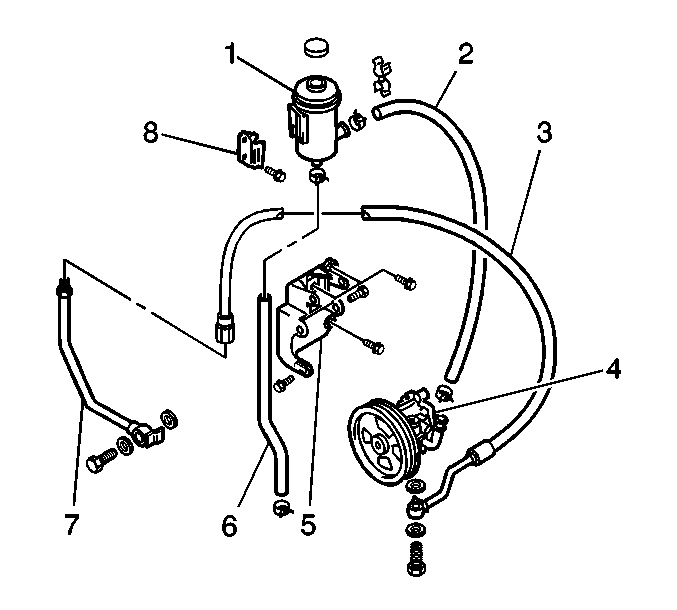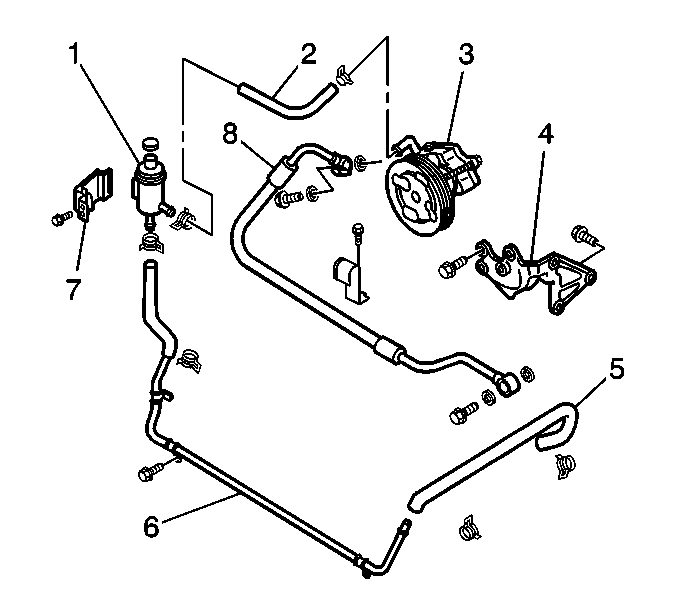Power Steering Fluid Reservoir Outlet Hose Replacement 1.6L
Removal Procedure
- Loosen the power steering fluid reservoir outlet hose clamp at the power steering pump (4).
- Place a drain pan under the vehicle in order to catch any escaping fluid.
- Remove the power steering fluid reservoir outlet hose (2) from the power steering pump.
- Loosen the power steering fluid reservoir outlet hose clamp at the reservoir (1).
- Remove the power steering fluid reservoir outlet hose from the reservoir.
- Remove the power steering fluid reservoir outlet hose from the hose clip.

Notice: Do not start the vehicle with any power steering gear inlet or outlet hoses disconnected. When disconnected, plug or cap all openings of components. Failure to do so could result in contamination or loss of power steering fluid and damage to the system.
Installation Procedure
- Install the power steering fluid reservoir outlet hose (2) to the reservoir (1).
- Install the hose clamp in order to retain the hose to the reservoir.
- Install the power steering fluid reservoir outlet hose to the hose clip.
- Install the power steering fluid reservoir outlet hose to the power steering pump (4).
- Install the hose clamp in order to retain the hose to the pump.
- Add power steering fluid to the reservoir. Refer to Checking and Adding Power Steering Fluid .
- Bleed the power steering system. Refer to Power Steering System Bleeding .

Notice: The inlet and outlet hoses must not be twisted during installation. Do not bend or distort the inlet or outlet hoses to make installation easier. Failure to follow these procedures could result in component damage.
Notice: When adding fluid or making a complete fluid change, always use the proper power steering fluid. Failure to use the proper fluid will cause hose and seal damage and fluid leaks.
Notice: If the power steering system has been serviced, an accurate fluid level reading cannot be obtained unless air is bled from the steering system. The air in the fluid may cause pump cavitation noise and may cause pump damage over a period of time.
Power Steering Fluid Reservoir Outlet Hose Replacement 2.0L
Removal Procedure
- Loosen the power steering fluid reservoir outlet hose clamp at the power steering pump (3).
- Place a drain pan under the vehicle in order to catch any escaping fluid.
- Remove the power steering fluid reservoir outlet hose (2) from the power steering pump.
- Loosen the power steering fluid reservoir outlet hose clamp at the reservoir (1).
- Remove the power steering fluid reservoir outlet hose from the reservoir.

Notice: Do not start the vehicle with any power steering gear inlet or outlet hoses disconnected. When disconnected, plug or cap all openings of components. Failure to do so could result in contamination or loss of power steering fluid and damage to the system.
Installation Procedure
- Install the power steering fluid reservoir outlet hose (2) and the hose clamp to the reservoir (1).
- Install the power steering fluid reservoir outlet hose and the hose clamp to the power steering pump (3).
- Add power steering fluid to the reservoir. Refer to Checking and Adding Power Steering Fluid .
- Bleed the power steering system. Refer to Power Steering System Bleeding .

Notice: The inlet and outlet hoses must not be twisted during installation. Do not bend or distort the inlet or outlet hoses to make installation easier. Failure to follow these procedures could result in component damage.
Notice: When adding fluid or making a complete fluid change, always use the proper power steering fluid. Failure to use the proper fluid will cause hose and seal damage and fluid leaks.
Notice: If the power steering system has been serviced, an accurate fluid level reading cannot be obtained unless air is bled from the steering system. The air in the fluid may cause pump cavitation noise and may cause pump damage over a period of time.
